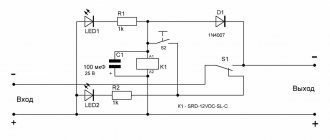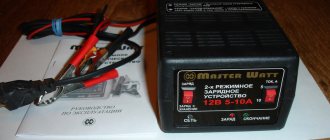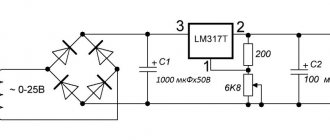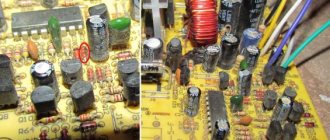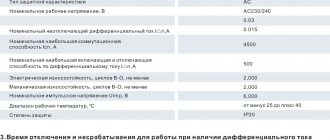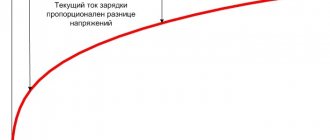What is an amplifier?
Low power signals are very common in electrical circuits. For example, this could be an audio signal from a dynamic microphone
weak radio signal that your Chinese radio picks up from the air
Or a reflected signal from an enemy missile, which is then caught, amplified and tracked by a radar installation. For example: TOP anti-aircraft missile system:
As you can see, in electronics absolutely everywhere there is a need to amplify weak signals. In order to amplify them, you need signal amplifiers. Amplifiers are widely used in radar, television, radio broadcasting, telemetry, computer technology, automatic control, automation systems, etc.
What is a black box in electronics
In general, an amplifier can be viewed as a black box.
What is this black box? This is a box. He's black). And since it is black, absolutely no one knows what is in it. We can only guess. But it is also possible that we can take some action and wait for a response. After the response of this black box, we can guess what is inside it.
That is, in essence, a black box must have some “sensors” for perceiving information from the outside, some “input”, as well as some “output” for a response. That is, by applying any influence to the input, we wait for the response of the black box at the output.
Let there be a cat or cat in the black box, but so far no one knows that he/she is there. What will we do first? Let's shake the box or kick it, right? If someone meows there, it means it’s definitely either a cat or a male cat). That is, there was a response. How to determine further whether it is a cat or a male cat? We open the box, and a shaggy miracle crawls out of it. If it runs, it means it's a cat. If it runs, it means it’s a cat).
But there can also be absolutely any body or substance in the black box. For such situations, we must conduct as many experiments as possible, that is, produce as many input influences as possible to more accurately determine the contents of the black box.
What is a quadripole
In electronics, a black box is a quadripole . What is a quadripole anyway? A four-terminal network is a black box containing an unknown electrical circuit inside. Here we see two input terminals, through which the input action is supplied, and two output terminals, from which we will now take the response of our “electric black box”.
Passive quadripole
For example, an RC circuit is a passive four-terminal network , since it has four terminals: two for input and two for output, and as we can see, it does not contain any power supply. This RC circuit is a passive low pass filter (LPF).
In passive two-terminal networks, the voltage or current at the output can be greater than at the input, but the power does not increase. How can the voltage or current at the output be greater than at the input? Here it is enough to recall the transformer, as well as series and parallel oscillatory circuits. For them, it would be more accurate to define a voltage converter, but not an amplifier, since the amplifier must include a power source from which it will take energy to amplify a weak input signal.
Also, in a passive four-port network, the output power will in no way be greater than the input power. If you achieve this, you will immediately receive an eternal source of energy and a Nobel Prize to boot. But remember that the law of conservation of energy, which was first formulated by Leibniz in the 17th century, has not been canceled.
Active quadripole
But we will now call this four-terminal network active , since it includes a power supply +Upit, which is required in order to amplify the signal.
That is, here we see two terminals for the input, to which the signal Uin is driven, and we also see two terminals for the output, where the voltage Uout is removed. Our four-port network is powered via + Upit, as a result of which, in this case, the output signal will be greater than the input signal.
By driving a sinusoid into the input of such a circuit, at the output we will get the same sinusoid , but its amplitude will be many times greater.
This is, of course, true for an ideal amplifier, i.e. absolutely linear and without restrictions on the amplitude of the input and output signals. In real amplifiers, it is required that the amplitude does not exceed the permissible value and that the amplifier is properly designed. In addition, any real amplifier introduces distortion and is characterized by nonlinear distortion coefficient (THD) and many other parameters, which we will consider in the next article.
In an active four-port network , one of which is a power amplifier, the output power will be greater than the input. Naturally, this does not violate the law of conservation of energy, since the power released to the load is the converted power of the power source. The small signal input simply controls this power. You can read more in the article about the principle of transistor amplification.
In electronics, we will consider an amplifier as an active four-port network , to the input of which a low-power signal Uin is supplied, and a load Rн is attached to the output.
Basic parameters of differential amplifiers
For further discussion, it is necessary to introduce concepts such as differential and common-mode signals that operate in a differential amplifier.
Differential signals
are signals of the same amplitude, but opposite in phase, present at the inputs of a differential amplifier, regardless of the grounding point of the amplifier.
Common Mode Signals
- these are signals that have the same amplitude and phase and are simultaneously present at both inputs of the differential amplifier.
It is quite simple to explain the meaning of these signals; as mentioned above, a differential amplifier is designed to amplify the difference between the signals at its inputs. Thus, if signals with different voltage levels arrive at the inputs of the amplifier at the same time, then these are differential signals, and if signals with identical voltage levels arrive at the inputs at the same time, then these are common-mode signals. Differential signals arrive at the amplifier input if you use a balanced input or unbalanced inputs for different signals in comparison circuits. Common-mode signals are, for example, an interference signal or thermal currents acting on the amplifier inputs at the same time at the same voltage level.
Thus, the signals at the inputs of the differential amplifier arrive in the form of the sum of differential and common-mode signals
Therefore, the input level of the differential signal will be equal to
and the differential signal gain
will be equal
Similarly with a common-mode signal. Common Mode Input Level
and common mode gain
will be equal
One of the main parameters characterizing the quality of a differential amplifier is the common-mode signal attenuation coefficient
(KOSS)
or in logarithmic form
Good differential amplifiers have CVSF = 104...106, which is 80...120 dB.
Generalized amplifier circuit
It looks something like this:
As we can see in the diagram, some source of a weak signal with EMF EI and internal resistance RI is connected to the input of the amplifier stage through terminals 1 and 2. It is this weak signal from this source that we will amplify. Further, as expected, each amplifier has its own input resistance Rin. The current strength Iin in the circuit EI -> RI -> Rin, as difficult as it may be to guess, will depend on the input resistance of the amplifier stage Rin.
As you already know, the power supply plays a major role in the amplifier stage. A low-power, weak signal controls the energy consumption of the power supply. As a result, at the output we get an amplified copy of the weak input signal. The amplification occurred due to the fact that the power supply provided its power to amplify the input signal. Well, something like this).
In the output circuit of the amplifier we receive an amplified signal with EMF (What is EMF) Eout and output resistance Rout. Through terminal blocks 3 and 4 we connect the load Rн, which will already consume the energy of the amplified signal. The current strength in the circuit Eout -> Rout -> Rн will depend on the load resistance Rн.
Differential amplifier circuit
An amplifier made according to an electric bridge circuit is called a differential amplifier and is designed to amplify the difference between two input signals. The simplest circuit of a differential amplification stage is presented below
Diagram of a differential amplification stage.
This circuit implements an electrical bridge, the shoulders of which are resistors R3 = R7 (collector loads of transistors) and the internal resistance of transistors VT1 and VT2 together with resistors R4', R4'' and R5. The power supply Ek is connected to one of the diagonals of the bridge, and the load connected to the output terminals (Output 1 and Output 2) is connected to the other. Resistors R1 = R7 and R2 = R8 are used to set the operating modes of the transistors, and resistors R4', R4'' and R5 are used to balance the bridge. Normal operation of the circuit is ensured by the symmetry of the electrical bridge; in this case, in the absence of an input signal from the input side (In.1 and In.2), the output voltage will be zero, regardless of changes in the supply voltage.
Amplifier types
Amplifiers can be divided into three groups:
Voltage amplifier
A voltage amplifier (VA) amplifies the input voltage a specified number of times. This coefficient is called voltage gain and is calculated by the formula:
Where
KU is the voltage gain
Uout - amplifier output voltage, V
Uin - voltage at the amplifier input, V
The output amplified voltage should not change from the load current, and therefore from the load resistance. Ideally, the output resistance Rout should be zero, which is unattainable in practice. Therefore, they try to design NAs in such a way as to minimize the output resistance Rout.
In this mode, the amplifier operates if the conditions are met that Rin is much greater than Rout, i.e. Rin >>Ri and Rn are much greater than Rout (Rn >>Rout). The higher the rating Rн, the better for the voltage amplifier, since the load will not sag the output voltage Uout. Everything is simple here: the lower the load resistance, the greater the current will flow through the circuit Eout -> Rout -> Rn, the greater the voltage drop across the output resistance Rout, based on the EMF formula: Eout = IoutRout + IoutRn. You can read about this in more detail in the article Ohm's Law for a complete circuit.
Current amplifier
The current amplifier (CA) amplifies the input current by a specified number of times. This coefficient is called the current gain and is calculated by the formula:
where KI is the current gain
Iout - current strength in the load circuit, A
Iin - current strength in the input circuit Ei ->Ri ->Rin, A
The meaning of the operation of the current amplifier is this: at a certain current strength in the input circuit, at the output in the load circuit we obtain a current strength that is KI times greater, regardless of what value the load rating takes. Ohm's simple law I=U/R already works here.
If the current strength must be constant, and our resistance value can be floating, then to maintain a constant current strength in the load circuit, our amplifier automatically changes the voltage Uout at the load. As a result, the current remained constant and remained the same. Or in letters: Rн =var, Iout= const.
You will tell your electronics teacher the above explanation, and now the explanation is for complete dummies . So, in the input circuit Ei -> Ri -> Rin, let us have a current flow of 10 mA. Coefficient KI = 100, therefore, at the output in the load circuit Eout -> Rout -> Rн a current with a force of 1 A (10 mA x 100) will flow. But such a current by itself will not flow through this circuit. It needs to create conditions for it to occur. Let's say we have a load of 10 ohms. What then should be the voltage in this circuit to obtain a current in this circuit of 1 A? Remember Uncle Om: I=U/R. 1=Uout/10, we get U=10 V. This is the voltage the current amplifier will give us at the output.
But what if the load changes its value? The current should remain the same, do not forget, that is, 1 A, since this is a current amplifier. In this case, so that the current in the circuit remains 1 A, the amplifier will automatically change its voltage value at the output Uout to 1=Uout /5. Uout =5/1=5 V. That is, we will already have 5 Volts at the output.
But we also do not forget about one more parameter, which is located in the output circuit of the current amplifier. This is the output resistance Rout. Therefore, we need the following condition to be satisfied: Rin << Ri and Rn << Rout at which the specified current in the load is ensured at a low voltage value.
Amplifier
It used to be very cool and fashionable to assemble power amplifiers (PA) with your own hands, turn on Tender May and turn the volume up to full blast. Now everyone can assemble or buy UM, since the Internet and Aliexpress are always at hand.
How does UM differ from UN and UT?
If in the UT we increased only the current, in the UN we increased the voltage, then in the UM we increased the current and voltage by a multiple of times.
The power formula for direct and alternating current with a resistive load looks like this:
Where
P—power, W
I - current strength, A
U—voltage, V
Therefore, the power gain will be written as:
Where
KP - power gain
Pout - amplifier output power, W
Pin - power at the amplifier input, W
For a power amplifier, the conditions for matching the input circuit with the source of the input signal and the output circuit with the load for transmitting maximum power have the form: Rin ≈ Ri and Rn ≈ Rout.
Also, do not forget that loads can be either purely active (such as an incandescent light bulb, a resistor, various heaters) or have a reactive component (inductors, capacitors, motors, etc.).
Calculation of the differential amplification stage
It is necessary to calculate a differential amplifier with the following parameters: change in input signal ∆UBX = 10 mV, signal source resistance RG = 1 kOhm, change in output voltage ∆UBbIX = 5 V.
- Let us select the amplifier supply voltage Ek, which should provide the specified amplitude of the output signal and not bring the transistor into saturation
- - the transistor at maximum amplitude should not enter saturation
where UCEsat is the saturation voltage of the transistors. For low-power UCEus = 1 V, for high-power UCEus = 2 V. - — supply voltage will be
Let’s take Ek = 15 V
- - the transistor at maximum amplitude should not enter saturation
- Let's choose the type of transistors in the amplifier stage. Let's choose a KT315 type transistor with the following parameters: UCEmax = 30 V, ICmax = 100 mA, ICBO = 1 mkA, fh21e = 250 MHz, h21e = 100, PK max = 150 mW.
- Let's take the collector current of transistors VT1 and VT2 IC = 1 mA and calculate the resistors that set the operating mode of these transistors:
- - collector resistors RC = R3 = R5
Let's take RC = 7.5 kOhm - - resistors in the base circuit Rb1=R1=R7, Rb2=R2=R8
Let's take Rb2=R2=R8 = 10 kOhmLet's take Rb1=R1=R7 = 150 kOhm
- - collector resistors RC = R3 = R5
- Let's calculate a source of stable current according to this article
- Let's choose a zener diode of type KS139G with the following parameters Ust.nom. = 3.9 V, Ist.nom. = 5 mA.
- - resistance of resistor R6
Let's take R6 = 2.2 kOhm - — resistance of resistor R4
Let’s take R4 = 1.6 kOhm - Let's determine the parameters of the differential cascade. To do this, we determine the differential output resistance of the stable current source
where rCE and rBE are the internal collector-emitter and base-emitter resistances of the transistorwhere Uγ is the Earley potential, which has the following values for npn transistors - 80...200 V, for pnp transistors 40...150 V UT - thermal potential equal to 26 mV for room temperature Thus, the output differential resistance of the current source will be
Differential Signal Gain
where RВХ is the input resistance of the differential amplifier
where R11 – equivalent input resistance Rb – equivalent base resistance
Then
and the differential gain will be
Common Mode Gain
Common mode rejection ratio
CVSF = 55803 times or 95 dB, which is a fairly good result, since if a conventional resistor of the order of several hundred Ohms was used instead of a current stabilizer, CVSF would be 50...60 dB, which is an insufficient value for the current level of development of electronic devices.
Amplifier output power
The output power of the amplifier delivered to the active load will be expressed by the formula:
Where
Pout - amplifier output power, W
Iout - current strength in the load circuit, A
UOut—load voltage, V
The power to the load with a reactive component will already be expressed through the formula:
Where
Pout - amplifier output power, W
Iout - current strength in the load circuit, A
Uout—load voltage, V
cosφ - where φ is the phase difference between the current and voltage oscillogram
For example, the phase difference between current and voltage in a resistive load is zero, therefore cos0=1. Therefore, the formula for the active load takes the form
You can read more about this in the article about active and reactance.
The maximum output power at which the distortion of the output signal does not exceed the quality values of the amplifier is called the rated power of the amplifier .
Well, a general rule, in order to make it easier to remember all these three types of amplifier:
In UN KU > 1, KI = 1; in UT KI > 1, KU = 1; in the mind KU > 1 and KI > 1.
Operating principle of a differential amplifier
As mentioned above, correct operation of a differential amplifier is possible with precise symmetry of the circuit. In this case, the quiescent current in both transistors and their change have the same value, as well as the voltages on the collectors of transistors VT1 and VT2. Thus, when external factors influence the transistors, the balance of the bridge is not disturbed, and the output voltage does not change. If the input voltage is applied to one or both inputs of the circuit, the internal resistance of one or both transistors changes and the bridge becomes unbalanced and the output voltage changes.
In real circuits it is quite difficult to ensure absolute symmetry of the circuit, therefore, to adjust the quiescent currents of transistors, resistors R4' and R4'' are used, which are sometimes combined into a common variable or tuning resistor, the resistance of which is
Differential amplification stages can operate with both balanced and unbalanced inputs and outputs. An unbalanced input is called if the input signal arrives at one of the inputs (In.1 or In.2) and the common pin, and a symmetrical input - the signal arrives between the input pins. In the case of the output, a similar naming occurs: an unbalanced output is one of the outputs (Output 1 or Output 2) and a common output, a symmetrical output is between the output pins Output 1 and Output 2.
Single-ended differential stages are typically used to transition from single-ended stages to balanced stages and vice versa.
Types of amplifiers by bandwidth
Based on bandwidth, amplifiers are divided into:
Low Frequency Amplifiers
They are also called audio frequency amplifiers (AF). They are designed to amplify signals with frequencies from tens of Hertz to 20 kHz. 20 kHz is the limit of frequency that can be perceived by the human ear. Therefore, this type of amplifier is very popular among music lovers and radio amateurs.
High frequency amplifiers
They are designed to amplify signals over the entire range of frequencies used by electronics.
Broadband amplifiers
They allow amplification of a wide frequency band (for example, from tens of hertz to several megahertz). Here, I think, everything is clear.
Narrowband amplifiers
They amplify a narrow frequency band. These can be resonant filters, as well as filters that are based on UHF and ULF.


